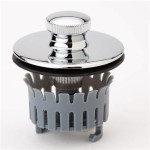Essential Aspects of Bathtub Faucet Washer
Bathtub faucet washers are essential components that contribute greatly to the smooth and efficient operation of a faucet. Understanding their significance and proper maintenance is crucial to ensure a trouble-free bathing experience. This content piece will delve into the essential aspects of bathtub faucet washers, uncovering their functions, types, common issues, and importance in faucet operation.
Functions of a Bathtub Faucet Washer
A bathtub faucet washer, also known as a rubber or washer, is a small, but vital component located within the faucet assembly. Its primary function is to create a watertight seal between the faucet stem and the faucet body, preventing water leakage. The washer accomplishes this by compressing slightly when the faucet is turned on, forming a seal that inhibits water from flowing out of the faucet unintentionally.
Types of Bathtub Faucet Washers
There are various types of bathtub faucet washers, each designed to fit specific faucet models. Some common types include:
- Flat washers: These are the most basic type of washer, consisting of a thin, rubber disc with a hole in the center. They are commonly found in older faucets.
- O-ring washers: These are doughnut-shaped washers that provide a more secure seal than flat washers. They are often used in newer faucets.
- Compression washers: These are conical-shaped washers that compress when the faucet is turned on, creating a tight seal. They are typically used in single-handle faucets.
Common Issues with Bathtub Faucet Washers
Over time, bathtub faucet washers can deteriorate due to constant use and exposure to water. Some of the common issues associated with faucet washers include:
- Leaking: A worn-out or damaged washer can cause water to leak from around the base of the faucet handle or from the spout.
- Dripping: A partially worn-out washer may allow a slow drip to occur, even when the faucet is turned off.
- Difficulty turning: A swollen or distorted washer can make it difficult to turn the faucet handle.
Importance of Bathtub Faucet Washers
Bathtub faucet washers play a crucial role in ensuring the efficient and trouble-free operation of a faucet. A properly functioning washer prevents water leakage and dripping, which can lead to water waste and potential damage to the bathroom. Furthermore, a worn-out washer can hinder the smooth operation of the faucet, making it difficult to control water flow and temperature.
Maintaining Bathtub Faucet Washers
To extend the lifespan of bathtub faucet washers and prevent common issues, proper maintenance is essential. Here are some tips:
- Regular inspection: Periodically check the faucet for any signs of leakage or dripping. A small leak can indicate a worn-out washer that needs replacement.
- Gentle cleaning: If the washer becomes dirty or clogged, gently clean it using a soft cloth or toothbrush. Avoid using harsh chemicals or abrasive cleaners.
- Proper installation: Ensure the faucet washer is installed correctly during faucet repair or replacement. A misaligned or improperly fitted washer can lead to premature failure.
By understanding the essential aspects of bathtub faucet washers and following proper maintenance practices, you can ensure a smooth and trouble-free faucet operation for a long time to come.

How To Fix A Leaking Bathtub Faucet Diy Family Handyman

Bathroom Fix It Tips How To Replace Washers In A Tub Valve

How Do I Replace Bathtub Faucet Washers

Gotonovo Clawfoot Bathtub Faucet Wall Mount Hand Held Shower Se

Fix Leaking Shower Head Or Bathtub Faucet Rebuild Replace Valve

How To Replace A Bathtub Faucet In 4 Easy Steps

How To Fix A Leaking Bathtub Faucet The Home Depot

How To Fix A Leaking Bathtub Faucet Diy Family Handyman

How To Fix A Leaky Bathtub Faucet 6 Ways Stop Drips

A Step By Guide On Bathtub Faucet Replacement







